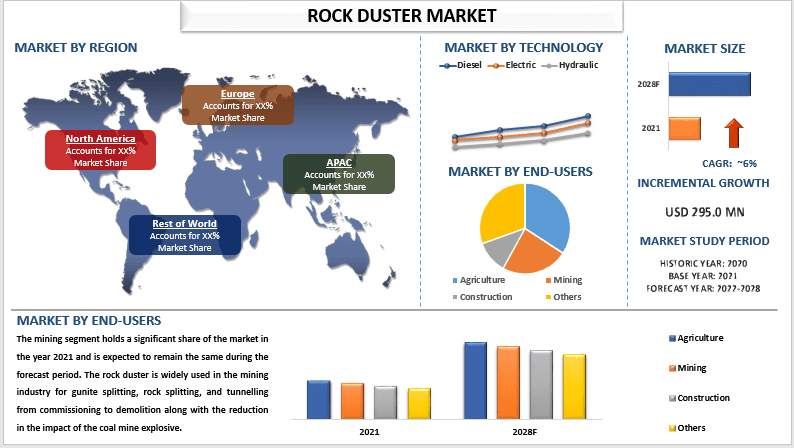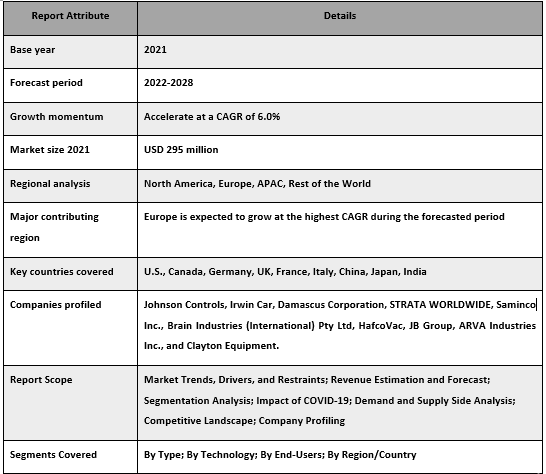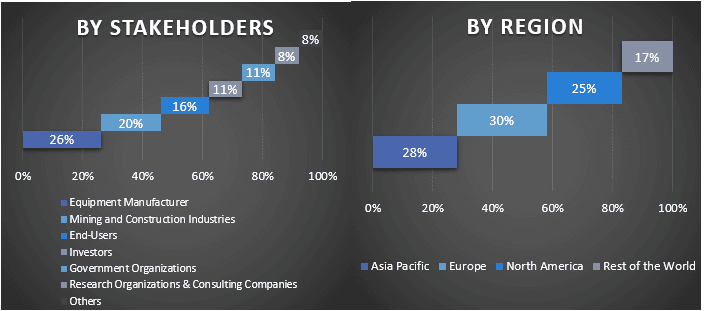- Accueil
- À propos de nous
- Industrie
- Services
- Lecture
- Contactez-nous
Marché des dépoussiéreurs de roche : Analyse actuelle et prévisions (2022-2028)
Accent sur le type (lanceur, humide/boue, Bantam, vrac haute pression, goutte à goutte et système d'époussetage automatisé à l'échelle de la mine) ; technologie (diesel, électrique et hydraulique) ; et utilisateurs finaux (agriculture, exploitation minière, construction et autres) ; et région/pays

Le marché des pulvérisateurs de roche était évalué à 295 millions USD en 2021 et devrait croître à un TCAC de 6,0 % de 2022 à 2028. Le saupoudrage de roche est une pratique minière souterraine où une fine poudre est appliquée sur les surfaces des travaux miniers, tels que les tunnels et les puits, pour empêcher la propagation des explosions de poussière de charbon. La poussière de roche agit comme un ignifuge et rend la poussière de charbon inerte, réduisant ainsi le risque d'explosion. Le marché des équipements de saupoudrage de roche devrait croître régulièrement dans les années à venir, sous l'impulsion de la demande croissante de charbon et d'autres minéraux et de la nécessité de pratiques minières sûres. L'adoption de technologies de pointe, telles que les systèmes automatisés de saupoudrage de roche, devrait également contribuer à la croissance du marché. Les pulvérisateurs de roche sont utilisés dans les mines pour disperser la poussière de roche, qui est une fine poudre utilisée pour contrôler l'explosion potentielle de la poussière de charbon dans les mines de charbon souterraines. L'utilisation de pulvérisateurs de roche est une mesure de sécurité importante qui aide à prévenir les explosions de poussière de charbon, qui peuvent être très dangereuses. L'adoption de pulvérisateurs de roche dans les mines s'est généralisée et est obligatoire dans les mines de charbon souterraines depuis de nombreuses années. Aux États-Unis, la Mine Safety and Health Administration (MSHA) exige que toutes les mines de charbon souterraines utilisent le saupoudrage de roche comme moyen de prévenir les explosions de poussière de charbon.
Certains des principaux acteurs opérant sur le marché comprennent Johnson Controls, Irwin Car, Damascus Corporation, STRATA WORLDWIDE, Saminco Inc., Brain Industries (International) Pty Ltd, HafcoVac, JB Group, ARVA Industries Inc. et Clayton Equipment. Plusieurs fusions et acquisitions ainsi que des partenariats ont été entrepris par ces acteurs pour faciliter l'accès des clients à des produits/technologies de haute technologie et innovants.
Aperçus présentés dans le rapport
« Parmi les types, le segment humide/boueux a détenu un TCAC important du marché en 2021 »
Selon le type, le marché est segmenté en lanceur, humide/boueux, bantam, vrac haute pression, goutte à goutte et système de dépoussiérage automatisé à l'échelle de la mine. Le segment humide/boueux devrait enregistrer un TCAC important au cours de la période de prévision. Un pulvérisateur de roche humide ou boueux est un équipement utilisé dans les opérations minières pour contrôler la poussière en pulvérisant un mélange d'eau et de poussière de roche sur les surfaces de la mine. Plusieurs facteurs peuvent affecter l'efficacité d'un pulvérisateur de roche humide ou boueux, notamment le type de poussière de roche utilisée, la pression de l'eau, le débit de la boue et la distance entre la buse et la surface pulvérisée. De plus, l'augmentation des activités minières ainsi que les progrès technologiques croissants devraient soutenir la croissance du marché dans les années à venir.
« Parmi les technologies, la technologie hydraulique détenait la part majoritaire du marché en 2021 »
Par technologie, le marché est segmenté en diesel, électrique et hydraulique. Le segment hydraulique devrait connaître une part de marché importante au cours de la période de prévision en raison de sa plus grande faisabilité et de ses meilleurs avantages en matière de refroidissement. De plus, le pulvérisateur de roche hydraulique est disponible en différentes tailles et poids et peut être utilisé pour un fonctionnement pratique et offre une plus grande flexibilité. En outre, la demande croissante de l'industrie minière attribuée au bruit plus faible, aux vibrations réduites et à un meilleur contrôle stimulera la demande d'équipements de pulvérisation de roche hydrauliques. Cependant, le marché des équipements à entraînement hydraulique devrait faire face à la concurrence des équipements à entraînement électrique en raison de la demande croissante de solutions durables et écologiques.
« L'Europe a dominé le marché des pulvérisateurs de roche en 2021. »
L'Europe a dominé le marché des pulvérisateurs de roche en 2021 en raison de la demande accrue d'équipements de pulvérisation de roche attribuée à la présence de plusieurs usines minières dans la région. De plus, la présence et l'extraction de plusieurs réservoirs de métaux tels que le cobalt, le béryllium, la bauxite et l'alumine, entre autres, soutiendront la croissance du marché dans les années à venir.
Couverture du rapport sur le marché des pulvérisateurs de roche

Raisons d'acheter ce rapport :
- L'étude comprend une analyse de la taille du marché et des prévisions validées par des experts clés authentifiés de l'industrie.
- Le rapport présente un aperçu rapide de la performance globale de l'industrie en un coup d'œil.
- Le rapport couvre une analyse approfondie des principaux pairs de l'industrie en mettant l'accent sur les principales données financières, les portefeuilles de produits, les stratégies d'expansion et les développements récents.
- Examen détaillé des moteurs, des contraintes, des principales tendances et des opportunités qui prévalent dans l'industrie.
- L'étude couvre de manière exhaustive le marché à travers différents segments.
- Analyse approfondie au niveau régional de l'industrie.
Options de personnalisation :
Le marché mondial des pulvérisateurs de roche peut être davantage personnalisé selon les besoins ou tout autre segment de marché. En outre, UMI comprend que vous pouvez avoir vos propres besoins commerciaux, n'hésitez donc pas à nous contacter pour obtenir un rapport qui répond parfaitement à vos besoins.
Table des matières
Méthodologie de recherche pour l'analyse du marché de la poudre de roche (2022-2028)
L'analyse du marché historique, l'estimation du marché actuel et la prévision du marché futur du marché mondial de la poudre de roche ont été les trois principales étapes entreprises pour créer et analyser l'adoption de la poudre de roche dans les principales régions du monde. Une recherche secondaire exhaustive a été menée pour collecter les chiffres du marché historique et estimer la taille actuelle du marché. Deuxièmement, pour valider ces informations, de nombreux résultats et hypothèses ont été pris en considération. De plus, des entretiens primaires exhaustifs ont également été menés avec des experts de l'industrie à travers la chaîne de valeur du marché mondial de la poudre de roche. Après l'hypothèse et la validation des chiffres du marché par le biais d'entretiens primaires, nous avons employé une approche descendante/ascendante pour prévoir la taille complète du marché. Par la suite, des méthodes de ventilation du marché et de triangulation des données ont été adoptées pour estimer et analyser la taille du marché des segments et sous-segments de l'industrie concernée. La méthodologie détaillée est expliquée ci-dessous :
Analyse de la taille du marché historique
Étape 1 : Étude approfondie des sources secondaires :
Une étude secondaire détaillée a été menée pour obtenir la taille du marché historique du marché de la poudre de roche par le biais de sources internes à l'entreprise telles que les rapports annuels et les états financiers, les présentations de performance, les communiqués de presse, etc., et des sources externes, notamment les revues, les actualités et les articles, les publications gouvernementales, les publications des concurrents, les rapports sectoriels, les bases de données tierces et autres publications crédibles.
Étape 2 : Segmentation du marché :
Après avoir obtenu la taille du marché historique du marché de la poudre de roche, nous avons mené une analyse secondaire détaillée pour recueillir des informations sur le marché historique et la part des différents segments et sous-segments pour les principales régions. Les principaux segments inclus dans le rapport sont le type, la technologie et les utilisateurs finaux. D'autres analyses au niveau des pays ont été menées pour évaluer l'adoption globale des modèles de test dans cette région.
Étape 3 : Analyse des facteurs :
Après avoir acquis la taille du marché historique des différents segments et sous-segments, nous avons mené une analyse des facteurs détaillée pour estimer la taille actuelle du marché de la poudre de roche. De plus, nous avons effectué une analyse des facteurs à l'aide de variables dépendantes et indépendantes telles que le type, la technologie et les utilisateurs finaux du marché de la poudre de roche. Une analyse approfondie a été menée pour les scénarios d'offre et de demande en tenant compte des principaux partenariats, fusions et acquisitions, expansions commerciales et lancements de produits dans le secteur du marché de la poudre de roche à travers le monde.
Estimation et prévision de la taille actuelle du marché
Taille actuelle du marché : sur la base des informations exploitables issues des 3 étapes ci-dessus, nous sommes parvenus à la taille actuelle du marché, aux principaux acteurs du marché mondial de la poudre de roche et aux parts de marché des segments. Tous les pourcentages de parts requis, les répartitions et les ventilations du marché ont été déterminés à l'aide de l'approche secondaire susmentionnée et ont été vérifiés par des entretiens primaires.
Estimation et prévision : pour l'estimation et la prévision du marché, des pondérations ont été attribuées à différents facteurs, notamment les moteurs et les tendances, les contraintes et les opportunités disponibles pour les parties prenantes. Après avoir analysé ces facteurs, les techniques de prévision pertinentes, c'est-à-dire l'approche descendante/ascendante, ont été appliquées pour parvenir à la prévision du marché pour 2028 pour différents segments et sous-segments sur les principaux marchés du monde. La méthodologie de recherche adoptée pour estimer la taille du marché comprend :
- La taille du marché de l'industrie, en termes de revenus (USD) et le taux d'adoption du marché de la poudre de roche sur les principaux marchés nationaux
- Tous les pourcentages de parts, les répartitions et les ventilations des segments et sous-segments du marché
- Les principaux acteurs du marché mondial de la poudre de roche en termes de produits proposés. De plus, les stratégies de croissance adoptées par ces acteurs pour rivaliser sur le marché en croissance rapide
Validation de la taille et de la part du marché
Recherche primaire : des entretiens approfondis ont été menés avec les principaux leaders d'opinion (KOL), notamment les cadres de haut niveau (CXO/VP, chef des ventes, chef du marketing, chef des opérations, chef régional, chef de pays, etc.) dans les principales régions. Les résultats de la recherche primaire ont ensuite été résumés et une analyse statistique a été effectuée pour prouver l'hypothèse énoncée. Les informations issues de la recherche primaire ont été consolidées avec les résultats secondaires, transformant ainsi l'information en informations exploitables.
Répartition des participants primaires dans différentes régions

Ingénierie du marché
La technique de triangulation des données a été utilisée pour compléter l'estimation globale du marché et pour parvenir à des chiffres statistiques précis pour chaque segment et sous-segment du marché mondial de la poudre de roche. Les données ont été divisées en plusieurs segments et sous-segments après avoir étudié divers paramètres et tendances dans les domaines du type, de la technologie et des utilisateurs finaux sur le marché mondial de la poudre de roche.
L'objectif principal de l'étude du marché mondial de la poudre de roche
Les tendances actuelles et futures du marché mondial de la poudre de roche ont été mises en évidence dans l'étude. Les investisseurs peuvent obtenir des informations stratégiques pour fonder leur discrétion en matière d'investissement sur l'analyse qualitative et quantitative effectuée dans l'étude. Les tendances actuelles et futures du marché ont déterminé l'attrait global du marché au niveau régional, offrant une plateforme aux participants industriels pour exploiter le marché inexploité afin de bénéficier d'un avantage de premier arrivé. Les autres objectifs quantitatifs des études comprennent :
- Analyser la taille actuelle et prévue du marché de la poudre de roche en termes de valeur (USD). De plus, analyser la taille actuelle et prévue du marché des différents segments et sous-segments
- Les segments de l'étude comprennent les domaines du type, de la technologie et des utilisateurs finaux.
- Définir et analyser le cadre réglementaire de la poudre de roche
- Analyser la chaîne de valeur impliquée avec la présence de divers intermédiaires, ainsi qu'analyser les comportements des clients et des concurrents de l'industrie.
- Analyser la taille actuelle et prévue du marché de la poudre de roche pour la région principale.
- Les principaux pays des régions étudiées dans le rapport comprennent l'Asie-Pacifique, l'Europe, l'Amérique du Nord et le reste du monde
- Profils d'entreprises du marché de la poudre de roche et stratégies de croissance adoptées par les acteurs du marché pour se maintenir sur le marché en croissance rapide.
- Analyse approfondie au niveau régional de l'industrie
Connexes Rapports
Les clients qui ont acheté cet article ont également acheté










